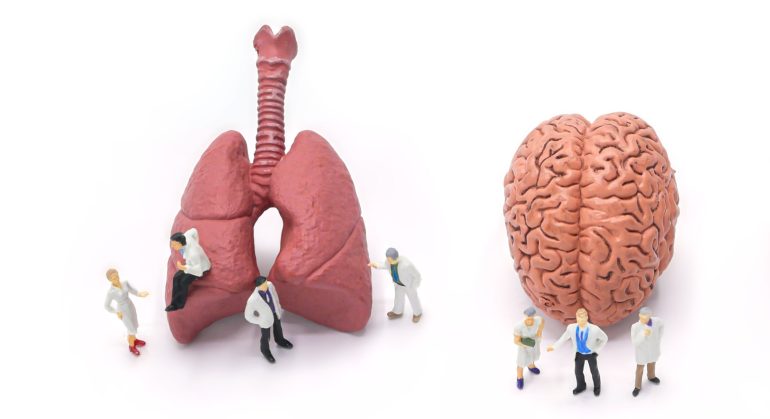Previously unknown interaction between lungs and brain
lung It is our most important exchange surface with the environment when it comes to the supply of oxygen. A microbial flora on which little research has been done so far resides on this infection, known as the lung microbiome. A German research team is now able to establish for the first time a close relationship between this microbiome Brain to signal
Researchers from the Institute for Neuroimmunology and Multiple Sclerosis Research at the University Medical Center Göttingen (UMG) have documented for the first time how the microbial flora of the lungs regulates the immune readiness of the brain. These interactions may also be the cause of destructive autoimmune inflammation. The results of research work were recently published in the famous journal “Nature“be released.
Lung flora closely examined for the first time
All contact surfaces that connect people to the outside world are colonized by bacteria. As part of the current study, the UMG Working Group found that bacterial colonization of the lungs at the contact surface between lung tissue and inhaled air plays a special role.
Lung microbiome more influential than previously thought
The team establishes a new and unexpected functional connection between the lungs and the brain. Accordingly, the lung microbiome sends continuous signals to the brain, leading to the so-called microglia to be influenced. Microglia can be thought of as the “immune cells of the brain”.
“Microglia adapt their immunological response to these microbial cues and can therefore respond in good time to impending threats,” said study lead author Dr. Leon Hosang.
Lung microbiome as an early warning system for the brain
“The Lung Microbiome Therefore Acts as a Species” early warning system for sensitive brain tissue,” said Professor Dr. Francesca Odordi, who led the Professor Dr. Alexander Flugel research project.
According to the research team, this hitherto little studied connection between the lungs and the brain could have far-reaching health implications. For example, lung infections, antibiotic treatment, air pollution and climate change can alter the lung flora and thus the immune activity within the brain.
Lung flora is smaller than intestinal flora
In recent years many researches have dealt with the effect of intestinal flora on human health. In comparison, according to the research team, the number of studies on the microbiome in the lungs is relatively small.
Possible causes of autoimmune diseases
In fact, for a long time it was believed that the lungs have no vegetation at all and are sterile. Göttingen’s work group showed not only that the lung flora is more influential than previously thought, but that even the smallest changes in this microbiome increase brain sensitivity. autoimmune diseases Change.
Antibiotics keep the brain on alert
For example, researchers were able to document how the lung microbiome sent a signal to the brain after the administration of antibiotics, which put the microglia in the brain on alert. According to the working group, “antibiotic-mediated manipulation of the lung microbiome was associated with clearly measurable and even microscopically visible changes in microglia”.
Furthermore, according to the study, microglia responded less strongly to inflammatory signals, resulting in reduced recruitment of immune cells to inflamed brain tissue. “This very conclusively explains the reduced susceptibility to autoimmune inflammation,” conclude the scientists.
new approach to treatment
According to the researchers, the microglia were paralyzed after the administration of antibiotics. The origin of this reaction can be traced to a certain type of bacteria in the lungs that produce a special cell wall component called lipopolysaccharide.
After antibiotics are given, this cell wall component accumulates more in the lungs. The increased amount of lipopolysaccharide resulted in “paralysis” of the microglia in the brain. On the other hand, a decrease in lipopolysaccharide in the lungs had the effect of enhancing autoimmune processes in the brain.
“maybe it’s new” lung-brain axis Even use it therapeutically,” suspects Professor Flugel. A targeted administration of probiotics or certain antibiotics to specifically affect immune responses in the brain is conceivable.
This may be the case, for example, in the treatment of multiple sclerosis play a role, but also in general, all diseases of the central nervous system in which microglia are involved.
Similar effects via the gut-brain axis
More recently, another study showed a similar relationship between the gut microbiome and immune responses in the brain. For more information see the article “Gut-brain axis opens new therapeutic approaches for cancer and autoimmune diseases“. (VB)
Author and source information
This text matches the medical specialist literature, medical guidelines and specifications of current studies and has been checked by medical professionals.
Author:
Graduate Editor (FH) Volker Blasecki
Swelling:
- Universitätsmedizin Göttingen: The lung–brain axis: The microbial flora of the lung modulates the immune readiness of the brain (Published: February 24, 2022), The European Union
- Hosang, L., Canal, R. C., van der Flier, F. J. et al. The lung microbiome regulates brain autoimmunity. Nature (2022). https://doi.org/10.1038/s41586-022-04427-4, nature.com
- Hiltensperger, M., Beltran, E., Kant, R. et al. Skin and gut imprinted helper T cell subsets display distinct functional phenotypes in central nervous system autoimmunity: In: Nature Immunology (2021), nature.com
Important Articles:
This article is general advice only and should not be used for self-diagnosis or treatment. He cannot take the place of visiting the doctor.

Web guru. Amateur thinker. Unapologetic problem solver. Zombie expert. Hipster-friendly travel geek. Social mediaholic.





